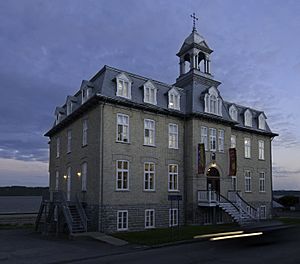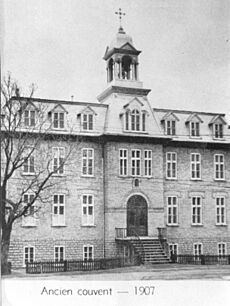Centre d'Interprétation de la Côte-de-Beaupré facts for kids
 |
|
| Established | 1984 |
|---|---|
| Location | 7976 avenue Royale, Château-Richer, Quebec, Canada |
Aux Trois Couvents is a cool museum in Château-Richer, Quebec, Canada. It used to be called the Centre d'interprétation de la Côte-de-Beaupré (CICB). This museum teaches you all about the history, old buildings, and amazing discoveries from the Beaupré Coast area.
It's been officially recognized since 1996. The museum is also part of the Route de la Nouvelle-France, which is one of Quebec's oldest roads. You can explore different exhibits and join fun learning activities there.
Contents
Discovering the Museum's Story
The Aux Trois Couvents museum started in 1984. It's a non-profit place, which means it's not trying to make money. The Ministry of Culture and Communications (Quebec) supports it.
At first, the museum was located at the Moulin du Petit-Pré. But in 2000, it bought an old convent building in Château-Richer. After a lot of hard work to fix it up, the museum moved into the former convent. This move made the museum four times bigger!
The museum helps visitors learn about the land, history, and culture of the Beaupré Coast. It's a great way to explore the past of this special region.
Exciting Exhibitions to Explore
The Aux Trois Couvents museum has several cool exhibitions. They help you understand the history of the area and the three convents of Château-Richer.
- Regards sur la Côte-de-Beaupré looks at the social and historical journey of the region. It covers everything from early colonial times to today.
- Site archéologique des Vieux-Couvents d'hier à aujourd'hui focuses on the history of the three convents. You can see real items found during archaeological digs at the site.
- Sur les traces de l'archéologie helps you understand the museum's location even better. It explains the history of the site and what modern archaeologists do.
- Olivier Le Tardif introduces a very important person from the 1600s. He was key to settling the Château-Richer area and starting New France.
- The Classe d'antan is a recreated classroom from the early 1900s. You can see what school was like for students back then.
The museum also has special learning activities. Sometimes, they even have temporary exhibits that change throughout the year.
The Story of Château-Richer's Convents
The First Convent: A School from the Past
Before the first convent was built, there was a windmill on this land. It stood near the St. Lawrence River around 1655. In 1998, archaeologists found the old foundations of this windmill.
In 1694, François de Laval ordered the first convent to be built. He was the first bishop of New France. This building was meant to be a school for girls. Nuns from the Congregation of Notre-Dame became the teachers. They were led by Marguerite Bourgeoys.
Three nuns taught young girls how to read, write, and count. They also taught history, geography, religion, and housework. Boys in the area went to school at the local manor house. In 1759, British soldiers led by General James Wolfe attacked the area. They took resources and burned many buildings, including this first convent.
The Second Convent: Facing Challenges
In 1829, a second convent was built on the same foundations. Starting in 1830, it became a girls' school again. This time, a different group of nuns, the Congregation of Our Lady of Charity of the Good Shepherd, taught there.
Even with many repairs, the building started to fall apart. This was because of floods and bad drainage. The dampness and dirty drinking water caused teachers and students to get sick. So, in 1906, the building was taken down. This made way for a new, better-planned building.
The Third Convent: A New Beginning
Construction on the third convent began in 1907. This new building was much larger. It had a chapel, a kitchen, a dormitory, and places for the nuns to live. It also served as a school, but this time for both boys and girls!
Teachers from the Sisters of Our Lady of Perpetual Help taught there at first. Later, regular teachers took over. In 1972, a brand new school was built nearby. It could hold many more students. So, the third convent building became a community center. In 2002, the building was given to the CICB, which is now Aux Trois Couvents.




